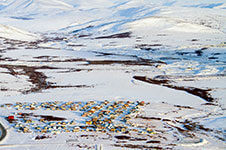In 1935 Billy Mitchell famously stated in a Congressional Testimony that “I believe in the future, whoever holds Alaska will hold the world… It is the most important strategic place in the world.” Anybody who lives in Alaska likely knows this quote by heart, and anyone who has served there probably has written and memorized these words. While Mitchell was mocked for this statement in his time, today he has been proved prescient in ways he couldn’t have predicted.
Fast forward to the 21st century and Alaska has not just remained important, it has grown in importance. With growing tension overseas, glaring security gaps in the US Arctic, and underserved populations in the state, there is a growing recognition that it is pressing for the United States to take the necessary steps to adequately defend Alaska and, thus, the nation as a whole.
Quintillion’s Senior Strategic Advisor, ret. General Charles H. Jacoby, Jr. first developed a passion for the Arctic, Alaska, and the people of Alaska during his military service in the state. During his time of service in the High North, General Jacoby served as the Deputy Commander of Alaska Command, the commander of US Army, Alaska, and ended his career as the commander of NORAD and US Northern Command.
He joined Quintillion’s strategic team in 2020, providing instrumental insight into the role of national security in Alaska and the value and potential subsea fiber holds for enhancing communication and defense in the North American Arctic. In response to Michell’s still pertinent words, General Jacoby notes, “It has become less about who holds Alaska. It’s about who can dominate in an opening, accessible, and resource-rich Arctic with strategic avenues in North America.”
As an Arctic expert and skilled military strategist, General Jacoby strongly advocates that adequate communication systems in the Arctic are critical for contending in this highly competitive space, and that Quintillion’s system has the capabilities to fill in gaps and keep America well-prepared to defend the homeland.
The Strategic Importance of the Alaskan Arctic

When General Jacoby served in Alaska, he gained immense insight into the strategic significance of Alaska in regard to national security and the glaring vulnerability gaps that existed ten years ago – and still impact the nation today.
When working with the US Northern Command, or Northcom, he was concerned across a spectrum of concerns and requirements: safety, security, and defense. Part of this role included supporting other vital organizations, such as FEMA and the Coast Guard. His command of NORAD provided similar support in the High North with Canada – with Alaska being front and center in considering how to best defend North America.
Alaska and the Cold War Era
General Jacoby claims that it was during the Cold War that Alaska’s strategic importance on a global scale first became realized. American leadership identified a need for advanced defense systems in the North American Arctic due to its proximity to Soviet Russia. In response, multiple systems were established in the High North. First, there was the Distant Early Warning Line in the 1950s, which was a series of radar stations designed to detect enemy bombers that spanned from Alaska to Iceland.
In the 1980s, the DEW Line was shut down as new technological advancements made this three-decade old warning system outdated and ineffective at adequately warning the US of an incoming nuclear threat. Several of the sites were upgraded as part of the new North Warning System. This unmanned early warning system became fully active in the early 1900s, with 13 long-range and 36 short-range sites that are jointly managed by Canda and the US through NORAD.
The Need for Modernized Arctic Warning Systems
With the end of the Cold War, the effort diminished, and modernization stopped. By the time General Jacoby arrived in 2011 as the Northcom and NORAD Commander, these warnings systems had fallen into disrepair, and it was difficult to gain attention.
General Jacoby remarked, “It was frustrating we couldn’t get the kind of attention that we needed for the capabilities required to do the mission in Alaska. Everything up there was out of date, everything up there was Cold War vintage, and there was a general yawning whenever I talked to folks about what was coming.”
In the last decade, world events have only supported the strategic importance of the Arctic and revealed that a continued effort to modernize Arctic warning systems is key for protecting the homeland on all fronts from threats abroad.
These growing threats are from state actors — not terrorists — but state actors. China, Russia, North Korea, and Iran were the four identified in the national security strategy 2017.
In 2014, the annexation of Crimea validated that Russia was a growing problem – in addition to competition from China and nuclear threats from North Korea. There has also been increased awareness around climate change and how it is has opened up access to the Arctic and Alaska.
There’s a confluence of all that activity right around where Alaska sits, and world superpowers are all attempting to dominate and gain advantage over the natural resources and strategic routes that the swiftly fluctuating Arctic is unveiling.
All Domain Warfare
In explaining the threats that Alaska and the rest of the nation are facing, General Jacoby stated that these state threats are “not just ICBM’s tanks and battleships and propeller-driven bombers.”
These threats are across all domains. Whether it’s space, cyberspace, underseas manned, unmanned on the surface, and now hypersonics, meeting these new threats to the homeland relies on digital communications and data.
The early Arctic warning systems of the past were considered “fast” when facing ICBMs to get a warning, and then having a response time of 20 to 25 minutes. It’s down to seconds now.
The whole air picture changed as well. Clumsy, old bear bombers have been replaced with stealthy cruise missiles that are very low and hard to observe and detect. In the future, we may be facing hypersonics that are hard to defend and travel at Mach 5-9.
We need strategic standoff, all-domain early warning. This is not just a local problem. It’s a global problem. It’s a global threat panorama that happens to be best addressed – and first addressed – in Alaska.
The Defense Department is not asleep at the switch. Everybody is leaning forward and taking advantage of the capabilities and capacities of the digital age, and the big emphasis right now is to exploit some of our unique capabilities to do what we call “all domain joint warfare”.
All domain warfare is difficult and requires total buy-in and dedication on all fronts to achieve. It’s about using all the instruments of national power in concert, and doing it instantaneously. It’s about being able to detect, assess, respond decisively with whatever the right tool is at the right time — whether it’s, the use of violence in kinetics, information, or making a presence known somewhere. Whatever the answer is, it requires an enormous amount of data. Not just the collection of it, but the transport, processing, and curating of it – and then being able to use it for decision-making.
Yes, all domain warfare is a great idea and exactly what our country needs to actively defend against these threats. However, you first require the basic infrastructure to transport that data in the amounts that are needed to run machine learning, AI, and all the other technology required to make domain warfare work. Without that kind of infrastructure, our nation will never be able to full exploit and conduct the type of all domain warfare that’s envisioned. We’re expending a lot resources on it, but it’s like spending a lot of money on cars and when no one has started building interstate highways yet.
Why Fiber is Vital for Enhancing Capabilities in the Arctic
Fiber is the true interstate highway of data, and Quintillion is providing it where it’s most needed in the Alaska Arctic. Through its 1700-mile subsea and terrestrial fiber optic system, Quintillion has brought high-speed broadband with resilient, secure transportation of data in real-time to the North American Arctic. This system is available now for security, safety and defense organization, and Alaskan communities to take advantage of.
Meeting Alaska’s Critical Communication Needs
General Jacoby recalls that when he was in Alaska in 2000, while there are other ways to pass data in the Arctic, “you were better off sending Morse code.” Between problems with the electromagnetic spectrum, inadequacies with satellite internet at the time, and a general lack of digital infrastructure, the options to pass data and use the internet were incredibly limited.
Not only does a lack of reliable broadband create a significant gap for Alaskans living in these regions of the state, but it severely hampers the military in Alaska from being able to adequately defend the nation against very real, pressing threats.
There’s an important duality of Quintillion’s missions between serving the people of Alaska and the security interest of the nation.
General Jacoby states, “Alaskans have to have access. We have this tremendous, powerful state of Alaska. Powerful in numbers and in industry… powerful in opportunity, resources, ideas, and in pioneering our way through a future of an open Arctic.”
While the harsh Arctic landscape and historical issues with communication are a continuing challenge, a strong middle-mile fiber network enables last-mile internet providers to serve underserved communities in Alaska and digitally connect them to the rest of the world.
Connecting the Arctic to Its Allies
Quintillion’s mission doesn’t end with the construction of its groundbreaking American Arctic fiber cable system. Quintillion started its mission because it saw a need and a unique ability to meet that need.
A reliable, affordable, and high-capacity fiber cable system in the High North is the exact infrastructure needed to modernize warning systems in the North American Arctic, and Quintillion is actively forging partnerships to support the United States in providing necessary national security.
Quintillion has a vision and strategy to extend its system and connect Alaska and the National Security establishment globally and digitally to our allies in Asia and Europe – and eventually around the world.
Want to learn more Quintillion’s subsea fiber optic cable system and how it’s brining the gold standard of connectivity to the Alaska Arctic? Contact our team to get in touch or read the Quintillion blog to stay on top of the latest industry news.















